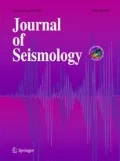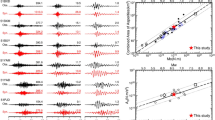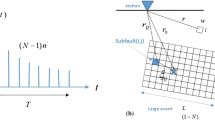Abstract
An earthquake sequence comprising almost 2000 events occurred in February–July 2001 on the southern coast of the Corinth Gulf.Several location methods were applied to 171 events recorded by the regional network PATNET. The unavailability of S-wave readings precluded from reliable depth determination. For the mainshock of April 8, ML= 4.7, the depth varied from 0 to 20 km. The amplitude spectra of complete waveforms at three local stations (KER,SER, DES; epicentral distances 17, 26 and 56 km) were inverted between 0.1 and 0.2 Hz for double-couple focal mechanism and also for the depth. The optimum solution (strike 220°, dip 40°, rake ‒160°, and depth of 8 km) was validated by forward waveform modeling.Additionally, the mainshock depth was further supported by the P- and S-wave arrival times from the local short-period network CRLNET (Corinth Rift Laboratory).The scalar seismic moment was 2.5e15 Nm,and the moment rate function was successfully simulated by a triangle of the 0.5 second duration. This is equivalent to a 1–1.5 km fault length, and a static stress drop 2–6 MPa. This value is important for future strong ground motion simulation of damaging earthquakes in Aegion region, whose subevents may be modeled according to the studied event. The T axis of the mainshock (azimuth 176° and plunge 67°), is consistent with the regional direction of extension ∼N10°. However, none of the nodal planes can be associated to an active structure seen at the surface. The relationship of this earthquake sequence with deeper faults (e.g. possible detachment at about 10 km) is also unclear.
Similar content being viewed by others
References
Armijo, R., Meyer, B., King, G., Rigo, A. and Papanastassiou, D., 1996, Quaternary evolution of the Corinth rift and its implications for the late Cenozoic evolution of the Aegean, Geophys. J. Int. 126, 11–53.
Bernard, P., Briole, P., Meyer, B., Lyon-Caen, H., Gomez, J.-M., Tiberi, C., Berge, C., Cattin, R., Hatzfeld, D., Lachet., C., Lebrun, B., Deschamps, A., Courboulex, F., Laroque, C., Rigo, A., Massonnet, D., Papadimitriou, P., Kassaras, J., Diagourtas, D., Makropoulos, K., Veis, G., Papazisi, E., Mitsakaki, C., Karakostas, V., Papadimitriou, E., Papanastassiou, D., Chouliaras, G. and Stavrakakis, G., 1997, The Ms=6.2, June 15, 1995 Aigion Earthquake (Greece): Evidence for Low Angle Normal Faulting in the Corinth Rift, J. Seismol. 1, 131–150.
Bouchon, M., 1981, A simple method to calculate Green's functions for elastic layered media, Bull. Seism. Soc. Am. 71, 959–971.
Briole, P., Rigo, A., Lyon-Caen, H., Ruegg, J.C., Papazissi, K., Mitsakaki, C., Balodimou, A., Veis, G., Hatzfeld, D. and Deschamps, A., 2000, Active deformation of the Corinth rift, Greece: results from repeated Global Positioning System surveys between 1990 and 1995, J. Geophys. Res. 105, 25605–25625.
Clarke, P.J., Davies, R.R., England, P.C., Parsons, B.E., Billiris, H., Paradissis, D., Veis, G., Denys, P.H., Cross, P.A., Ashkenazi, V., Bingley, R., 1997, Geodetic estimation of seismic hazard in the Gulf of Corinth, Geophys. Res. Lett. 24, 1303–1306.
Coutant, O., 1989, Program of Numerical Simulation AXITRA. Research report, LGIT, Grenoble.
Hatzfeld, D., Karakostas, V., Ziazia, M., Kassaras, I., Papadimitriou, E., Makropoulos, K., Voulgaris, N. and Papaioannou, C., 2000, Microseismicity and faulting geometry in the Gulf of Corinth (Greece), Geophys. J. Int. 141, 438–456.
Janský, J., 2000, Grid search hypocentral location method in simple 1-D media, Acta Montana IRSM AS CR, Series A 118, 71–84.
Janský, J., 2001, Ray-method calculations of the travel times and take-off angles in gradient models, program ANGGRA, Research report, Dept. of Geophysics, Faculty of Math. and Phys., Charles University, Prague.
Janský, J., Zahradník, J., Sokos, E., Serpetsidaki, A. and Tselentis, A., Relocation of the 2001 earthquake sequence in Aegion, Greece, using grid search, Studia geoph. et geod., submitted.
Lee, W.H.K. and Valdes, C.M., 1989, Hypo71PC Toolbox for seismic data acquisition, processing, and analysis, IASPEI & SSA.
en.html
Novotný, O., Zahradník, J. and Tselentis, G.-A., 2001, North-Western Turkey earthquakes and the crustal structure inferred from surface waves observed in Western Greece, Bull. Seism. Soc. Am. 91, 875–879.
Pacchiani, F., Lyon-Caen, H., Bourouis, S., Bernard P. and Deschamps, A., 2002, Cluster relocation in the Corinth rift and fault geometry, book of abstracts, XXVIII Gen. Ass. ESC, Genoa, 1–6 September 2002.
Plicka, V., Sokos, E., Tselentis, G.-A. and Zahradník, J., 1998, The Patras earthquake (July 14, 1993) — relative roles of source, path and site effects, J. Seismol. 2, 337–349.
Rietbrock, A., Tiberi, C., Scherbaum, F. and Lyon-Caen, H., 1996, Seismic slip on a low angle normal fault in the Gulf of Corinth: evidence from high resolution cluster analysis of microearthquakes, Geophys. Res. Lett. 14, 1817–1820.
Rigo, A., Lyon-Caen, H., Armijo, R., Deschamps, A., Hatzfeld, D., Makropoulos, K., Papadimitriou, P. and Kassaras, I., 1996, A microseismic study in the western part of the Gulf of Corinth (Greece): implications for large scale normal faulting mechanisms, Geophys. J. Int. 126, 663–688.
Tselentis, G.-A., Melis, N., Sokos, E. and Papatsimpa, K., 1996, The Egion June 15, 1995 (6.2 ML) earthquake, Western Greece, Pure appl. geophys. 147, 83–98.
Tselentis, G.-A. and Zahradník, J., 2000, The Athens earthquake of September 7, 1999, Bull. Seism. Soc. Am. 90, 1143–1160.
Zahradník, J., Janskí, J. and Papatsimpa, K., 2001, Focal mechanisms of weak earthquakes from amplitude spectra and polarities, Pure appl. geophys. 158, 647–665.
Zahradník, J., 2001, Focal mechanism of the Athens 1999 earthquake by ASPO method, Research report, Dept. of Geophysics, Faculty of Math. and Phys., Charles University, Prague; see also http://sei30.karlov.mff.cuni.cz.
Zahradník, J., 2002, Modeling the Skyros island, Aegean Sea Mw=6.5 earthquake of July 26, 2001, Studia geoph. et geod. 46, 753–771.
Zahradník, J. and Tselentis G.-A., 2002., Modeling strong-motion accelerograms by PEXT method, application to the Athens 1999 earthquake, Proc. XXVIII Gen. Ass. ESC, Genoa, 1–6 September 2002 (CD-ROM). See http://seis30.karlov.mff.cuni.cz.
Author information
Authors and Affiliations
Rights and permissions
About this article
Cite this article
Zahradník, J., Janský, J., Sokos, E. et al. Modeling the ML4.7 mainshock of the February–July 2001 earthquake sequence in Aegion, Greece. Journal of Seismology 8, 247–257 (2004). https://doi.org/10.1023/B:JOSE.0000021376.21087.2d
Issue Date:
DOI: https://doi.org/10.1023/B:JOSE.0000021376.21087.2d




